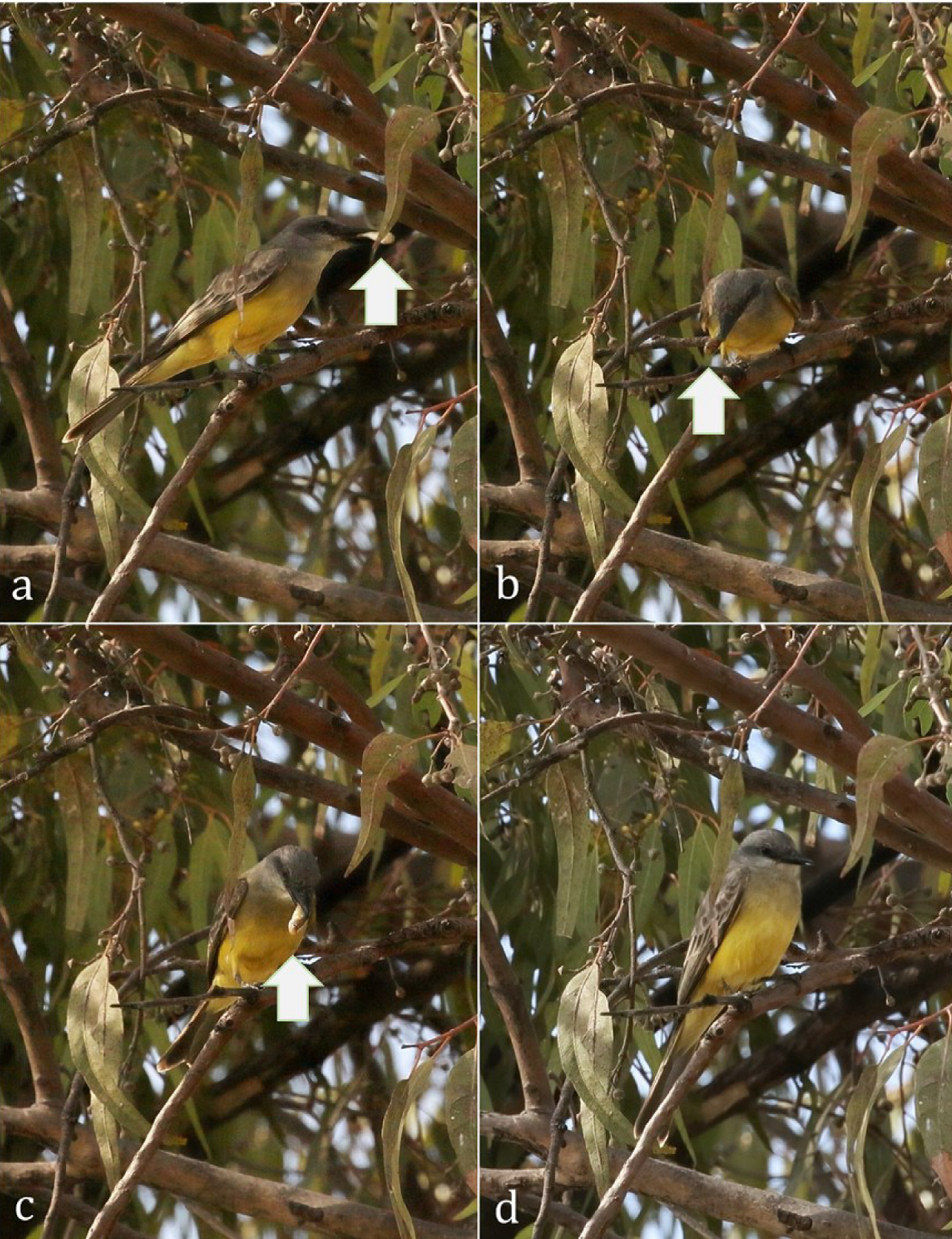With approx. 100 genera and 400 species, tyrant flycatchers (Tyrannidae) are among the most species-rich and ecologically diverse families of all Passeriformes (Alderfer 2014). Many tyrant flycatchers have a short, broad, and rather flattened bill, which vary in size and shape across the species, and constrain their food habits. Trophic preferences in tyrant flycatchers range from small (e.g., true flies, gnats and mites) to large insects (e.g., dragonflies, bees, and beetles) and other invertebrates. Even though they are considered primarily insectivores, a diverse array of additional foods (mainly small fruits and berries) can supplement their diet (Sibley 2001). It has been found that the larger species of Tyrannidae occasionally feed on small vertebrates, including hummingbirds and lizards (Fitzpatrick 1980, Latino and Beltzer 1999), and also fish, frogs and small mammals (Lopes et al. 2005, Alderfer 2014).
Kingbirds (Tyrannus sp.) are tyrant flycatchers that can be easily seen on exposed perches or sallying to prey upon flying insects (Alderfer 2014) in a diversity of habitats, such as open and semi-open country with scattered trees or on woodland edges, but also in a variety of landscapes modified by human activities (Stouffer and Chesser 1998). The Tropical Kingbird (T. melancholicus) is a medium-sized, conspicuous and widespread species that can be observed in most climatic regimes from the south of United States, and Mexico, to Argentina (Stouffer and Chesser 1998). It is one of the most specialized flycatchers and forages almost exclusively by sallying after large, flying insects (Stouffer and Chesser 1998). In one study, Fitzpatrick (1980) reported that 94% of 425 prey items were pursued and captured by aerial hawking (i.e., true flycatching). Also, Gabriel and Pizo (2005) reported that air was the most frequently used substrate (85.7% out of 196 foraging maneuvers).
Tropical Kingbirds can also be observed in human-made areas and man-modified ecosystems (Stouffer and Chesser 1998). For instance, González-Oreja (2011) found that this species had been registered in 55% of 11 bird assemblages inhabiting urban environments all through Mexico. One of those sites is the main campus of the Benemérita Universidad Autónoma de Puebla (in Puebla, the capital city of the State of Puebla, Mexico), commonly known as Ciudad Universitaria (CU). This is a 100-ha green space, with a diverse array of both native and exotic tree species, interspersed with open areas. The climate is temperate, subhumid, with rains during summer. The Tropical Kingbird is a common resident species in CU (Jiménez-Moreno and Mendoza-Cuamatzi 2010), where it can easily be observed and its presence was confirmed in 89% of the 37 transects we completed in CU during 2017 (unpublished own data).
On January 22th, 2018, at 10:20 h, we observed a Tropical Kingbird perched on a twig of a Eucalyptus camaldulensis tree that grows on the shore of one of the small bodies of water that can be found in CU (latitude 19°0’15.70’’ N; longitude 98°12’20.50’’ W). While on this perch, the bird spotted a prey on the water and suddenly attacked it from a height of approx. 5 m. Immediately, it returned to a different branch of the same tree, and we could clearly see that the prey was a small fish (Figure 1A). The bird handled the prey with its bill (Figure 1A-C) and, in less than 12 seconds, it had ingested the fish (Figure 1D). We have identified the fish as Poeciliopsis gracilis (Heckel, 1848), a Nearctic, introduced species in this region (Handal-Silva et al. 2011).

(photo: José Antonio González-Oreja)
Figure 1 Tropical Kingbird (Tyrannus melancholicus) preying on fish in the main campus of the “Benemérita Universidad Autónoma de Puebla”, in Puebla, Mexico. Just after catching the fish (A), the bird handled it with its bill (B, C) and ingested it (D). The first (A) and the last (D) images are separated by only 12 seconds. In all panels, arrows point to the fish. All the pictures were taken on January 22th, 2018, at 10:20 h, with a Canon EOS 7D Mark II, equipped with a Canon EF 100-400mm f/4.5-5.6l IS II USM lens, shot at 400 mm.
To the best of our knowledge, this is the first time this behavior (i.e., piscivory) has been reported for the Tropical Kingbird. Although Fitzpatrick (1980) studied how this species captured 425 preys in a number of sites in South America, he did not mention the identity of prey species. Nevertheless, he observed Great Kiskadees (Pitangus sulphuratus) scavenging dead fish and hunting for live fish. Furthermore, in Santa Fe, Argentina, Alessio et al. (2005) studied the feeding ecology of 13 passerine species, including the Tropical Kingbird. Among the six Tropical Kingbird stomachs they analyzed, with 103 preys in total, no fish was found. In fact, no fish was reported among the prey of any of the five Tyrant Flycatcher species they studied (Alessio et al. 2005). Finally, Jahn et al. (2010) studied the foraging behavior and trophic ecology of the Tropical Kingbird in the Southern Amazon Basin. After analyzing 44 fecal samples, no fish was reported.
Lopes et al. (2005) published a literature review on passerine birds acting as predators of small vertebrates within the Neotropical Region. Although they compiled the results for 5,221 stomachs from birds of 24 families (including 1,073 tyrant flycatcher stomachs), their conclusion was that vertebrate predation by passerines is uncommon. Only 0.3% of the stomachs contained vertebrate remains, and fish was found in only one. Nevertheless, considering also direct field observations, they asserted that the ability to prey on vertebrates seems to be widely distributed among the 203 Neotropical passerine species they considered.
Two species in the same Tropical Kingbird genus have been reported preying opportunistically on fish: the Grey Kingbird (T. dominicensis) and the Eastern Kingbird (T. tyrannus) -for references, see Lopes et al. (2005). We show that the Tropical Kingbird must be added to that list. Although it appears to be an incidental behavior, it is still necessary to determine its frequency and ecological role.











 text new page (beta)
text new page (beta)


